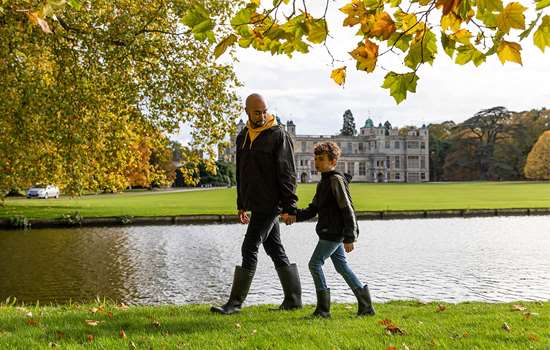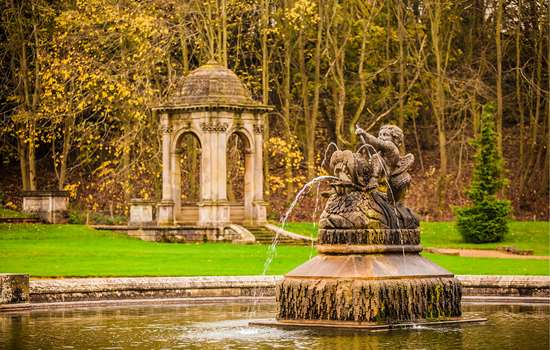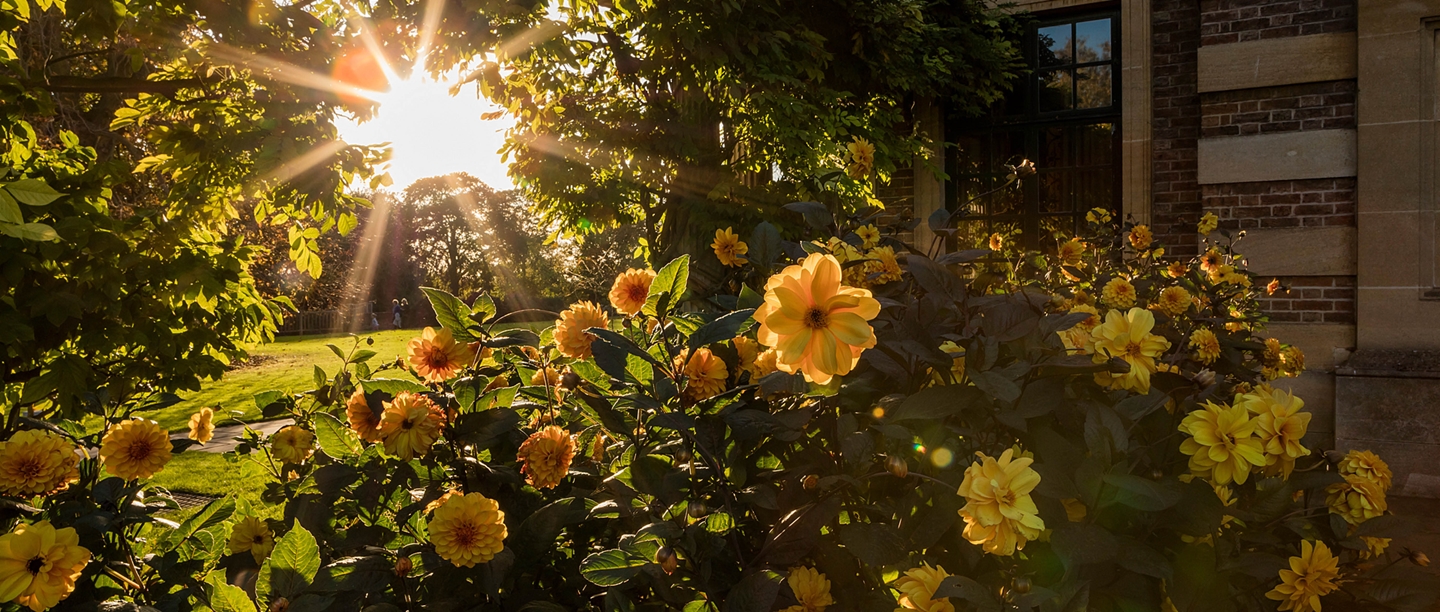1. Cyclamen
When:
September–December
Where:
Brodsworth Hall and Gardens
Mount Grace Priory
Walmer Castle and Gardens
The dainty jewel-like flowers of cyclamen (Cyclamen hederifolium) start to emerge in autumn and can be seen right through the winter, adding colour to the shaded areas they thrive in. Hardy, outdoor cyclamen can be found in shades of strong pinks through to white.
The Roman writer, Pliny the Elder, wrote of cyclamen in his Natural History, suggesting them as both a poison and a cure. The tuberous roots of cyclamen contain a toxin which has given cyclamen a long association with superstition and health.
Cyclamen were introduced to Britain in around 1597 and can be found under trees and in shaded areas at many of our sites.
2. Japanese anemone
When:
Late August–October
Where:
Eltham Palace and Gardens
Walmer Castle and Gardens
Osborne
A star of autumn gardens, Japanese anemone (Anemone hupehensis, Anemone x hybrida) are tall saucer-shaped flowers that float alongside silvery buds above foliage which dies back in the winter after flowering, and returns in spring. These plants are sometimes also known as 'windflowers' for their gentle nodding movement in the wind.
Despite their name, Japanese anemones originate from China, but have been grown in Japanese gardens for centuries. They were first brought to Britain by the plant collector Robert Fortune in the mid-19th century.
Japanese anemones feature in Osborne's walled garden. The swathes of pink flowers transform the area in early autumn, extending the garden's flowering period.
3. Autumn Crocus
When:
September–November
Where:
Belsay Hall, Castle and Gardens
Bolsover Castle
Brodsworth Hall and Gardens
Osborne
Walmer Castle and Gardens
Wrest Park
Autumn crocus (Colchicum autumnale) is not a true crocus. True crocus bloom in late winter and early spring.
These pale mauve flowers bloom in dense groups, on top of pale bendy stems, often in grassy areas where they can become established over several years. The flowers emerge from corms without leaves, which develop in spring. As a result, autumn crocus are sometimes called 'naked ladies'.
In ancient Greece, the autumn crocus was recognised for its powerful poison, but it also has a long history of attempts to refine medicinal properties from the plant.
In the 18th century, a French army officer, Nicholas Husson, developed a cure-all tonic called 'l’eau de Husson', which contained extract of autumn crocus. It became popular in high society after the Prince Regent, later George IV, used it to help treat his gout.
The alkaloid Colchicine was isolated from Colchicum in the 19th century and while still highly toxic, could be more reliably experimented with for its medicinal properties, including in the prevention of gout.
Autumn crocus have been grown in Britain since the beginning of the 17th century.
4. Dahlia
Best time to spot them:
August–early October
Where:
Eltham Palace and Gardens
Audley End House and Gardens
Osborne
Walmer Castle and Gardens
Wrest Park
Dahlias originate from southern and central America. They were first brought to Europe in the late 18th century, but not successfully grown in Britain until the early 19th century.
The first 'single' flowers were soon bred to produce a variety of colours and fancier 'double' blooms, which became incredibly popular in the first half of the 19th century. Since then, dahlias have fluctuated in popularity, at some points being considered vulgar and only fit for allotments.
At English Heritage, dahlias can be found growing from kitchen gardens and walled gardens for cut flowers (Walmer and Wrest Park), to bedding arrangements and summer displays (Osborne, Eltham and Audley End), reflecting their changing popularity through history.
Did you know? Stonehenge once hosted dahlia shows. During the 1840s, Stonehenge was the unlikely venue for dahlia shows, which featured competitions to find the best blooms, 'floral devices' – sculptures made entirely dahlias – live music, a 'universal picnic', and even a cricket match.
5. Rudbeckia
Best time to spot them:
August–October
Where:
Kenilworth Castle and Elizabethan Garden
Eltham Palace and Gardens
Mount Grace Priory
Rudbeckias originate from north America and today can be found in a dazzling range of shades of yellows and oranges, in various shapes and sizes.
They were brought to Britain in the early 17th century by the Tradescant plant collectors.
Rudbeckia are sometimes called 'cone flowers' and their dark solid centres leave behind attractive seed heads into late autumn and early winter.
6. Chrysanthemum
When:
September–November
Where:
Audley End House and Gardens
Carisbrooke Castle
Home of Charles Darwin – Down House
Walmer Castle and Gardens.
Chrysanthemums come in a huge array of sizes, shapes and colours. They can produce a plentiful supply of cut flowers in autumn, right through to early winter.
Chrysanthemums originate from China, where they have been grown for centuries as a herb. Chrysanthemums are also very significant in Japanese culture, associated with royalty, having been brought to Japan through trade with China in around the 5th century.
Chrysanthemums are thought to have been introduced to Europe in the 17th century and were very popular as a cut flower in the 19th century as they can last for almost two weeks. At our sites, you can usually find them in kitchen gardens and cutting borders.
Did you know? The diary of William Cresswell, a gardener at Audley End during the 1870s, refers to potting on Chrysanthemums into larger pots. So we know these autumnal flowers were grown at Audley End in the late 19th century.
7. Michaelmas Daisies
When:
August–late October
Where:
Bolsover Castle
Eltham Palace and Gardens
Osborne
Kenilworth Castle and Elizabethan Garden
Michaelmas daisies (Symphotrichum, formely Asters) provide fantastic late summer colour and a source of nectar for pollinators, from August through to October. 'Michaelmas' daisies are at their peak in late September, where their flowers coincide with the feast day of St Michael the Archangel, on 29 September.
The flowers have come to symbolise the start of autumn and the shorter days leading into winter. Michaelmas daisies were popular with the Victorians and Edwardians.
Garden designers William Robinson and Gertrude Jekyll both used asters for their soft billowy flowers, which suited their softer planting schemes in the early 20th century.
8. Nerines
When:
Flowering in September and October
Where:
Eltham Palace and Gardens
Osborne
Walmer Castle and Gardens
Wrest Park
Nerines grow from bulbs and flower during September and October. They form tall stems, topped with clusters of trumpet-shaped flowers with curly petals mostly commonly found in shades of pink.
The plant doesn't have visible leaves during the flowering period and are a popular bloom for flower arranging. You can find nerines at Eltham Palace, Osborne, Walmer Castle and Wrest Park, where they add a last pop of colour to the late summer planting.
Nerines are a South African plant, brought to Europe in the 17th century.
Did you know? There's a 'wild' population of nerines growing on the Channel Island of Guernsey, said to have become established after a box of the bulbs washed up on the shore following a shipwreck. This legend has helped Nerines earn the common name of 'Guernsey Lily'.
9. Sasanqua camellia
Best time to spot them:
Late September–early November
Where:
Osborne
Did you know that some camellias flower in the autumn?
'Sasanqua' camellias might be less well-known than their spring flowering counterparts, but their smaller leaves and array of flower shapes and colours brighten up autumn gardens, particularly in sunny areas.
And they offer a rare chance for scent in the garden after the height of summer.
Sasanqua camellia can be found in the pleasure grounds at Osborne and stand out as some of the last flowering shrubs towards the end of the year.
10. Bodinier beautyberry
When:
October–December
Where:
Kenilworth Castle and Elizabethan Garden
Walmer Castle and Gardens
The unusual Bodinier beautyberry plant (Callicarpa bodinieri) from western and central China is a showstopper in autumn. In summer, it produces small pale purple clusters of flowers, followed by glossy, round, purple berries in the autumn.
The Bodinier beautyberry is named after Emile Marie Bodinier, a French missionary and plant collector who sent back a specimen of the plant in the 1890s. It was only made more widely available after 1907.
Its striking and unusual colour made it a popular exotic choice for gardens in the early 20th century. To get the most berries, a number of plants must be grouped together, which might have caused a decline in its popularity.
More to explore
-

Plan your visit
From sweeping parkland to pretty parterres, find a place to visit and explore historic gardens this autumn.
-

Gardens through time
Use our timeline to trace the evolution of gardens in England and see if you can spot the signs of historical landscape design on your next visit.
-

Join English Heritage
Enjoy unlimted access to our glorious gardens and historic sites with an annual English Heritage membership.
